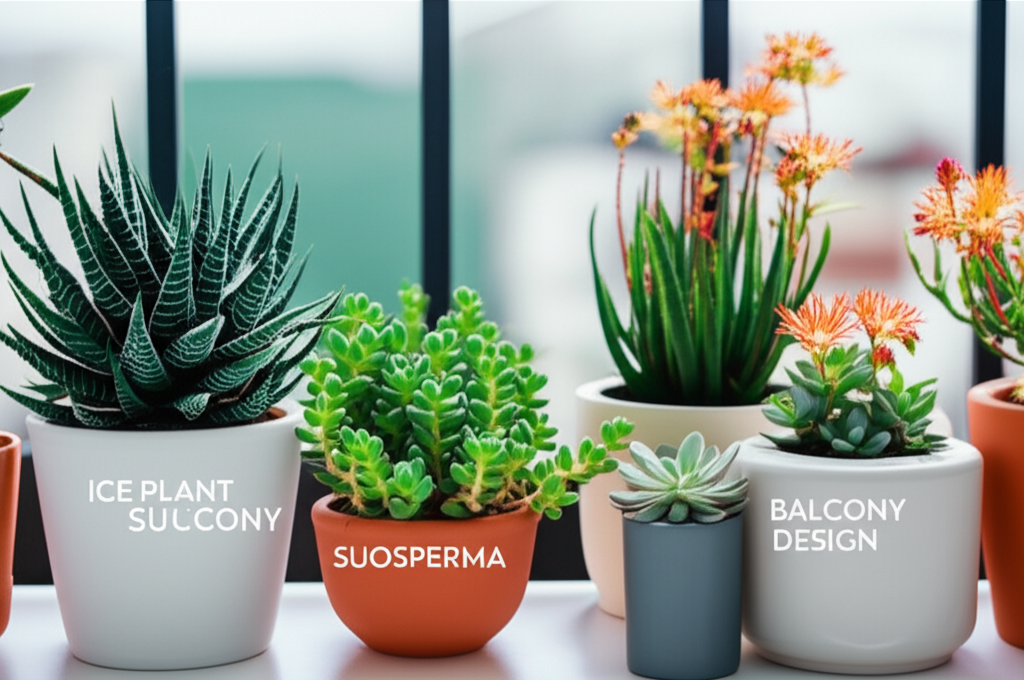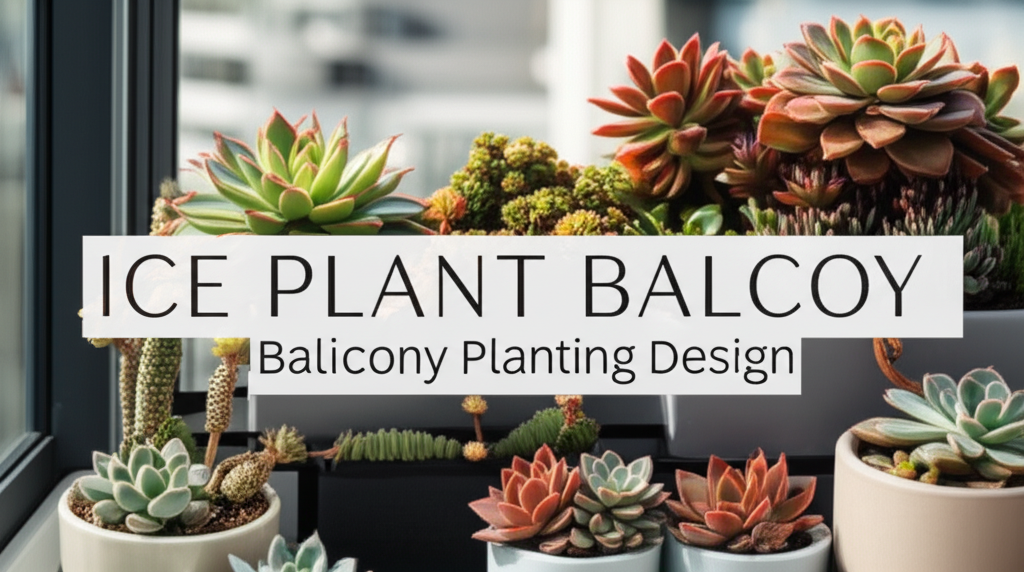Introduction: The Allure of Ice Plant Succulents on Your Balcony
Balconies, often overlooked as mere extensions of our living spaces, possess incredible potential to become vibrant, low-maintenance oases. For urban dwellers and those with limited garden space, container gardening offers a fantastic solution. Among the myriad of plant choices, succulents have surged in popularity, and for good reason. Their drought tolerance, striking aesthetics, and diverse forms make them ideal for container gardening. Within the succulent family, the “ice plant” genus (Mesembryanthemum and related genera) stands out with its unique crystalline structures, dazzling blooms, and remarkable resilience.
This guide delves into the world of ice plant succulents, specifically focusing on how to design and implement a stunning and successful planting scheme for your balcony. We will explore their unique characteristics, the benefits they bring to a small outdoor space, and provide a step-by-step approach to creating a captivating ice plant succulent display that thrives with minimal fuss. Prepare to transform your balcony into a sun-drenched haven of texture and color.
Understanding Ice Plant Succulents: More Than Just Pretty Faces

The term “ice plant” can refer to a variety of succulents, primarily from the Aizoaceae family. What unites them is their remarkable adaptation to arid environments, which translates into their suitability for sunny, exposed balcony conditions. Many species are characterized by vesicular tissues, small, blister-like cells on their leaves and stems that can reflect sunlight, help reduce water loss, and even collect dew. This gives them a shimmering, “icy” appearance, hence their common name.
Key Characteristics of Ice Plant Succulents
- Drought Tolerance: Perhaps their most celebrated trait, ice plants are exceptionally water-wise, making them perfect for busy individuals or those prone to forgetting to water.
- Sun Lovers: They thrive in full sun, which is often abundant on balconies, ensuring vigorous growth and abundant flowering.
- Low Maintenance: Beyond occasional watering and well-draining soil, ice plants require very little attention. They are generally pest and disease resistant.
- Diverse Forms: From low-spreading groundcovers to upright shrubby varieties, there’s an ice plant to suit various design aesthetics.
- Striking Flowers: Many ice plants produce vibrant, daisy-like flowers in a spectrum of colors, often opening in the morning sun and closing in the evening.
- Unique Textures: The vesicular tissues, along with fleshy leaves and stems, provide fascinating tactile and visual appeal.
Why Ice Plant Succulents are Ideal for Balcony Gardens
Balconies present unique challenges and opportunities for gardening. They are typically exposed to strong sunlight and wind, and space is often at a premium. Ice plant succulents are perfectly adapted to these conditions:
- Maximizing Sunlight: Their sun-loving nature means they will flourish in the bright light typical of most balconies, transforming stark surfaces into vibrant displays.
- Wind Resistance: Their sturdy, often compact growth habit makes them naturally resistant to wind, preventing them from being easily toppled or damaged.
- Space Efficiency: Many ice plant varieties are naturally compact or trailing, making them ideal for containers and vertical planting designs.
- Water Conservation: Given their drought tolerance, they are excellent choices for balconies where water runoff can be an issue or where water access might be less convenient.
- Aesthetic Appeal: Their unique textures and bright blooms add significant visual interest and a touch of the exotic to urban living spaces.
Planning Your Ice Plant Balcony Design: From Concept to Creation
A well-planned design is crucial for a successful and aesthetically pleasing balcony garden. Before you even buy a single plant, consider these key elements:
Assessing Your Balcony Environment
- Sunlight Exposure: Observe your balcony throughout the day. How many hours of direct sunlight does it receive, and at what times? This will determine which ice plant varieties will thrive.
- Wind Conditions: Is your balcony exposed to strong, persistent winds? This might influence your choice of containers and plant varieties, favoring lower-growing, more robust species.
- Space and Layout: Measure your balcony and consider its shape. Think about how you want to use the space – for relaxation, dining, or purely as a visual display.
- Weight Restrictions: Be mindful of any weight limits for your balcony, especially if you plan to use large containers filled with soil. Opt for lighter potting mixes and consider the weight of water-saturated soil.
- Water Access: How easily can you water your plants? Consider the proximity of a water source and whether you’ll need a watering can, hose, or even an automated system for larger setups.
Choosing the Right Ice Plant Varieties
The vastness of the ice plant family means there are many excellent choices for balcony gardening. Here are a few popular and well-suited examples:
| Common Name | Scientific Name | Growth Habit | Flower Color | Sun Exposure | Drought Tolerance |
|---|---|---|---|---|---|
| Common Ice Plant | Mesembryanthemum crystallinum | Low-growing, spreading | White, pink | Full Sun | Very High |
| Pink Carpet Ice Plant | Delosperma cooperi | Low-spreading groundcover | Bright Pink | Full Sun | Very High |
| Sunglow Ice Plant | Delosperma ‘Sunglow’ | Low-growing, mat-forming | Yellow | Full Sun | Very High |
| Mirror Plant | Conophytum species (various) | Tiny, paired leaves (split rocks) | Yellow, orange, pink, white | Partial to Full Sun | Very High |
| Living Stones (Lithops) | Lithops species (various) | Fleshy, stone-like leaves | Yellow, white, orange | Full Sun | Very High |
Container Selection and Preparation
The right containers are critical for the health and aesthetic of your ice plant succulent display.
- Material: Terracotta, ceramic, and concrete pots are excellent choices as they are porous and allow for good air circulation, preventing root rot. Plastic and metal can also be used but may require more careful watering to avoid overheating.
- Drainage: This is non-negotiable. Ensure all containers have drainage holes at the bottom. If a decorative pot lacks holes, consider drilling them or using it as a cachepot with a nursery pot inside.
- Size: Choose pots that are slightly larger than the root ball of your plants. Overly large pots can retain too much moisture. For trailing varieties, consider wider, shallower containers.
- Style: Select containers that complement your balcony’s aesthetic, whether modern, rustic, or minimalist. Consider a mix of sizes and shapes for visual interest.
Soil Mix: The Foundation for Success
Ice plant succulents demand a fast-draining soil mix. A standard potting mix will retain too much moisture. Create your own or purchase a specialized cactus and succulent mix.
- DIY Mix: A good ratio is 2 parts potting soil, 1 part perlite, and 1 part coarse sand or pumice.
- Benefits of the Mix: This blend ensures excellent aeration and drainage, preventing waterlogged roots which are the most common cause of succulent demise.
Designing Your Ice Plant Balcony Display: Creative Arrangements
Now for the fun part – bringing your vision to life! Think about creating layers, textures, and focal points to make your balcony truly captivating.
Monochromatic Magic: Single-Color Blooms
For a sophisticated and calming effect, select ice plant varieties with flowers in a single color palette, perhaps varying shades of pink or yellow. This can be incredibly impactful, especially when combined with plants that have different leaf textures.
Textural Contrasts: A Symphony of Forms
Pair low-spreading, mat-forming ice plants with slightly more upright or bushy varieties. The contrast in growth habit will create depth and visual interest. Consider incorporating other succulents with different leaf shapes and colors, like Echeverias or Sedums, to further enhance the textural play.
Cascading Wonders: Trailing Delights
Utilize hanging baskets or railing planters to showcase trailing ice plants like Delosperma cooperi. Their cascading stems, adorned with vibrant flowers, will create a waterfall of color that softens hard balcony edges.
Focal Points and Groupings
- Anchor Plants: Use larger, more prominent ice plants or attractive containers as anchors for your display.
- Grouping: Arrange pots of varying heights and sizes together to create a more cohesive and visually appealing arrangement. Consider a collection of smaller pots or a few larger statement pieces.
- Vertical Interest: Incorporate tiered planters or use shelves to add vertical dimension to your balcony garden.
Seasonal Considerations and Succession Planting
While ice plants are generally resilient, think about the overall seasonality of your balcony.
- Flowering Times: Different ice plant varieties may have slightly different blooming periods. By selecting a mix, you can potentially enjoy blooms for a longer duration.
- Complementary Plants: Consider interspersing non-succulent plants that offer seasonal color or foliage interest. However, ensure their watering and light needs are compatible with ice plants.
Caring for Your Ice Plant Succulent Balcony Garden
Once your design is in place, ongoing care is relatively simple, but crucial for maintaining healthy and beautiful plants.
Watering: The Art of Under-Watering
This is where many go wrong with succulents. Ice plants prefer to dry out completely between waterings.
- Frequency: Water only when the soil is dry to the touch, typically every 2-4 weeks in warmer months and even less in cooler periods.
- Method: Water thoroughly until water drains from the bottom of the pot. Avoid misting the foliage, as this can lead to fungal issues. Water the soil directly.
- Signs of Thirst: Leaves may start to appear slightly shriveled or less plump.
Sunlight: The More, The Merrier (Generally)
Most ice plants revel in full sun. However, in extremely hot climates, some species might benefit from a little afternoon shade to prevent leaf scorch. Observe your plants and adjust placement if necessary.
Fertilizing: Less is More
Ice plants are not heavy feeders.
- When: Fertilize sparingly, typically once in the spring and again in mid-summer, using a diluted, balanced liquid fertilizer formulated for succulents or cacti.
- Why: Over-fertilizing can lead to weak, leggy growth and reduced flowering.
Pruning and Maintenance: Keeping Things Tidy
- Deadheading: Remove spent flowers to encourage further blooming and keep the plants looking neat.
- Trimming: If plants become leggy or overgrown, you can trim them back. The cuttings can often be propagated to create new plants.
Pest and Disease Management
Ice plants are generally resistant to pests and diseases. However, overwatering can lead to root rot. If you notice any pests like mealybugs or aphids, they can usually be managed with a gentle spray of soapy water or insecticidal soap.
| Category | Details |
|---|---|
| Pros | Extremely drought-tolerant, requiring minimal watering. |
| Thrives in full sun, ideal for most balconies. | |
| Low maintenance, generally pest and disease-free. | |
| Cons | Can be susceptible to root rot if overwatered. |
| Some varieties may require protection in frost-prone areas. | |
| Requires well-draining soil; standard potting mix is insufficient. | |
| Steps to Success | 1. Assess balcony sunlight, wind, and space. |
| 2. Choose ice plant varieties suited to your environment. | |
| 3. Select pots with adequate drainage and appropriate size. | |
| 4. Prepare a fast-draining succulent soil mix. | |
| 5. Arrange plants considering texture, color, and form; water sparingly. |
Conclusion: Embrace the Shimmering Beauty of Your Ice Plant Balcony
Designing a balcony garden with ice plant succulents is a rewarding experience. Their unique beauty, coupled with their resilience and low-maintenance needs, makes them perfect candidates for transforming any urban outdoor space into a vibrant, living sanctuary. By understanding their requirements, carefully planning your design, and providing the right conditions, you can cultivate a breathtaking display of shimmering foliage and dazzling blooms that will bring joy and a touch of the extraordinary to your everyday life. So, embrace the simplicity, enjoy the process, and let your ice plant succulent balcony garden flourish!


